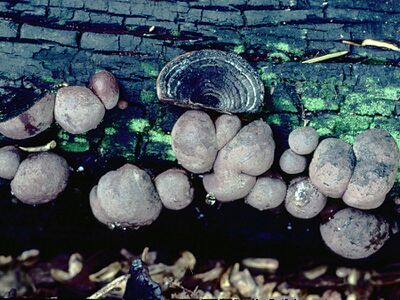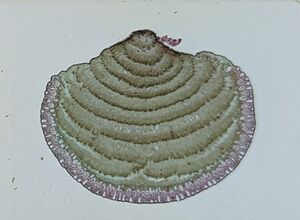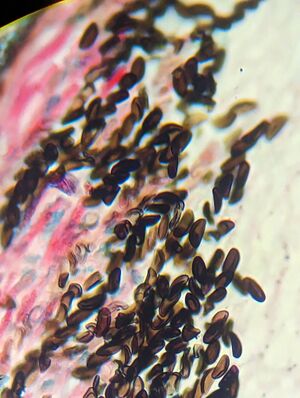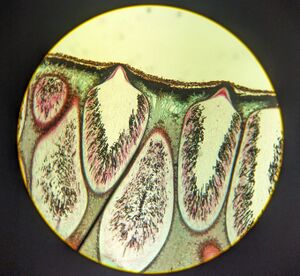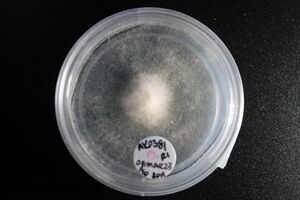User:Anaandrade: Difference between revisions
Anaandrade (talk | contribs) |
Anaandrade (talk | contribs) |
||
| Line 34: | Line 34: | ||
====<i>Daldinia childiae</i> subgroup==== | ====<i>Daldinia childiae</i> subgroup==== | ||
This group is characterized by yellowish-brown stomata pigments, due to the presence of daldinals and daldinins. The group appears to be more concentrated in warmer climates with few exceptions, and has been found in Eastern Asia, North America, and parts of Europe. | |||
====<i>Daldinia vernicosa - Daldinia loculata</i> subgroup==== | ====<i>Daldinia vernicosa - Daldinia loculata</i> subgroup==== | ||
Revision as of 21:58, 11 December 2023
Daldinia
Daldinia is a genus of endophytic fungal species from the family Hypoxylaceae in the order Xylariales. The genus is named in 1863 by the Italian mycologists Cesati & De Notaris, after Agostino Daldini (1817-1895), a Swiss monk, clergyman and botanist. It is known by several common names such as cramp balls, coal fungus, and King Alfred’s cake.
Morphology
Like other members of the Ascomycota division, sexual reproduction of this fungal genus is through the formation of ascospores within a sac-like ascus. The black fruiting body of Daldinia is hemi-spherical, 2-7cm wide, and is hard and friable. It is inedible and has a glebal hymenium which is purple, brown, or silvery black inside and is arranged in concentric layers. Much like how tree rings grow, the concentric layers are related to seasonal growth of the fruiting body. The cylindrical asci within the fruiting body are seen in the outermost edge of the perithecium, to allow for spore dispersal. The spores are dispersed when each ascus is engorged in fluid which extends outside the perithecium.
The ascospores of Daldinia have fairly thick walls and are often viable for years. There have been documented instances of ascospores germinated 11 years following the original collection of the ascospores. In its vegetative state, members of the Daldinia genus are often resistant to drought and cold, likely due in part by their ability to form the characteristic stromatic structures of the perithecium, as well as its ability to live endophytically within plants and lichen hosts.
Classification and Characteristics
Like many fungi, it is often considered a saprotroph and lives on decaying wood, with a strong preference towards burnt wood. Unlike other saprotrophs, however, members of the Daldinia genus also have an endophytic or endolichenic stage, in which they live within the tissues of healthy host plants. This particular stage of the Daldinia lifecycle likely gives the endosaprotrophic fungi a timely advantage following the death of its host. It is likely that they live within their hosts, only switching to the saprotrophic stage and developing stomata after the host has been damaged or killed by fire. When inhabiting a lichen, it appears symptom-less within lichen thalli, and associates closely with the algal or cyanobacterial partner in the thalli.
The Daldinia genus consists of endophytic fungi that acts as a generalist, and thus can form a mutualistic relationship with various woody plants and lichen. The fruiting bodies consist of pertithecia imbedded in large stomata which have internal concentric zones, which gives one of the most common species the name Daldinia concentrica . Given this shared trait, in Scandanavia and other European countries, Daldinia concentrica has been used as a given name for almost any species within the genus.
More recently, D. concentrica has been re-typed to show at least five different taxa of Daldinia are found in northern Europe alone, which were all previously thought to be D. concentrica .
Daldinia concentrica subgroup
This group is comprised of species and related taxa typically distributed in mild and subtropical temperatures of western and southern Europe, however there are some related taxa in tropical Africa and the Southern Hemisphere as well.
Daldinia eschscholtzii group
This group is composed almost exclusively of species from tropical and pantropical regions. Of this group, only D. caldariorum has been found in Europe, with all other species appearing to be endemic to the neotropics or east Asia.
Daldinia childiae subgroup
This group is characterized by yellowish-brown stomata pigments, due to the presence of daldinals and daldinins. The group appears to be more concentrated in warmer climates with few exceptions, and has been found in Eastern Asia, North America, and parts of Europe.
Daldinia vernicosa - Daldinia loculata subgroup
This group is characterized by its nearly cylindrical, ellipsoid-inequilateral ascospores with rounded ends. They can be mostly distinguished by morphological differences based on stroma anatomy, ascospore size, and anamorphic characteristics. The most commonly describes members of this group, D. vernicosa and D. loculata have been recorded in burnt and damages substrates, mostly Betulacea. Records of this group in the tropics are rare, as they are normally found in higher altitudes.
Daldinia petriniae subgroup
Named after the Swiss mycologist Lilian Petrini, this group seems to be the most evolutionary derived group among Daldinia, and is characterized by various features considered evolutionarily advances within the ascomycete and Xylariaceae such as highly reduced conidiogenous structures, dehiscent perispores, and early deliquescent asci in some among this group. There is evidence of a possible co-evolution with its predominant host family, Betulaceae .
Lifecycle and Ecology
It is well known that the stromata of Daldinia often serve as a habitat for several species of pyrophilous insects, which are strongly attracted to newly burnt areas, between 0-5 years following a fire. It is therefore suggested that species such as D. loculata are spread to burnt substrates by pyrophilous insects, which can detect smoke and heat from forest fires carried over large distances.
Ecology
What microbial processes define this environment? Describe microbial processes that are important in this habitat, adding sections/subsections as needed. Look at other topics in MicrobeWiki. Are some of these processes already described? Create links where relevant.
Current and Future Research Applications
Lab cultures of Daldinia spp. are able to grow on a broad range of substrates, often much faster than other Xylariaceae species, which is evidence of its ability to colonize a large range of host plants and lichen, as well as other woody substrates.
Uses
While inedible, species of Daldinia have been historically used as a form of tinder for lighting fires, as it burns well when dry. It burns slowly, much like charcoal, and releases a pungent smoke. This is likely another reason why it has been nicknamed the coal fungus .
Biofuels
Enter summaries of recent research here--at least three required
References
Edited by <your name>, a student of Mary Beth Leigh at the University of Alaska Fairbanks
Template adapted from one used by Angela Kent at the University of Illinois at Urbana-Champaign.
Other examples:
Bold
Italic
Subscript: H2O
Superscript: Fe3+
